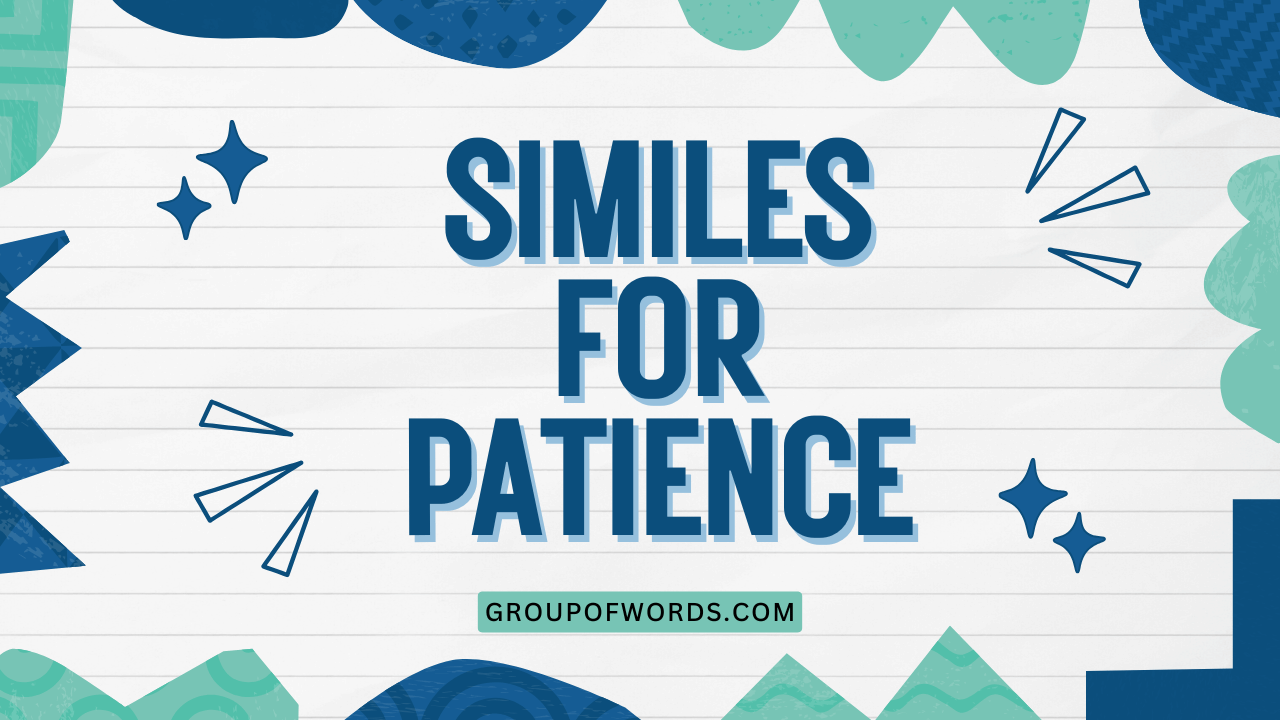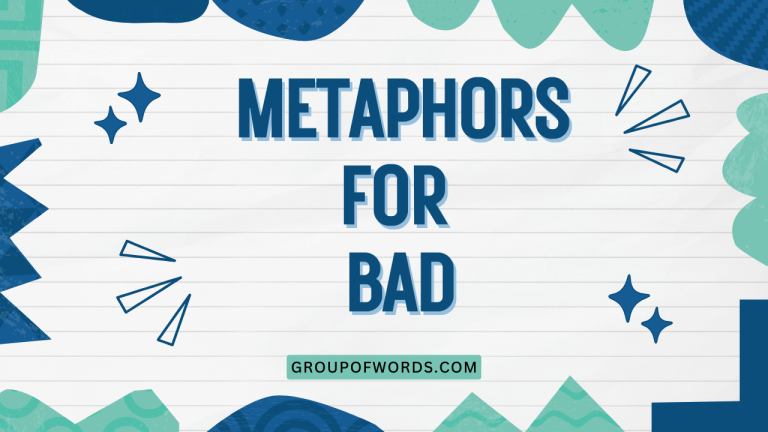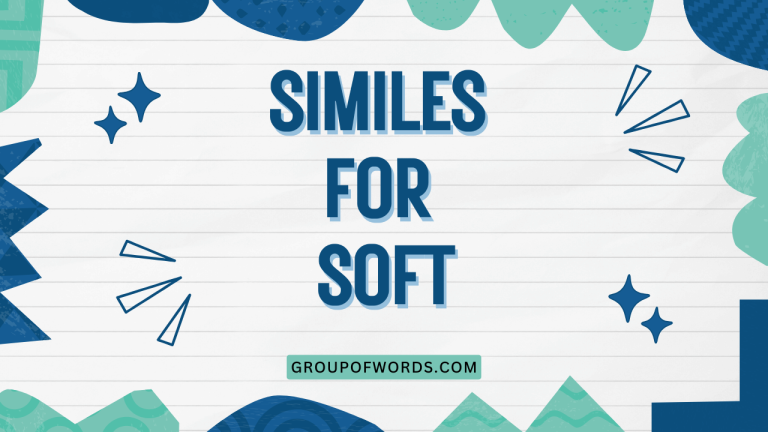Similes for Patience: A Comprehensive Guide
Patience, the ability to endure waiting, delay, or provocation without becoming annoyed or upset, is a virtue often praised but not always easily practiced. Similes, figures of speech that compare one thing to another using “like” or “as,” can vividly illustrate the essence of patience and its various facets.
This article provides a comprehensive exploration of similes for patience, delving into their structure, types, and usage, accompanied by numerous examples and practice exercises. Understanding and using these similes will not only enhance your vocabulary but also deepen your appreciation for the nuanced ways we describe and understand patience.
This guide is perfect for English language learners, writers, and anyone looking to improve their communication skills.
Table of Contents
- Introduction
- Definition of Simile and Patience
- Structural Breakdown of Similes for Patience
- Types of Similes for Patience
- Examples of Similes for Patience
- Usage Rules for Similes
- Common Mistakes When Using Similes
- Practice Exercises
- Advanced Topics in Similes
- Frequently Asked Questions (FAQ)
- Conclusion
Definition of Simile and Patience
A simile is a figure of speech that directly compares two different things using the words “like” or “as.” Its purpose is to illuminate a quality or characteristic of one thing by associating it with something else that is commonly understood to possess that quality. For example, “He is as brave as a lion” compares a person’s bravery to the well-known courage of a lion.
Patience, on the other hand, is the capacity to accept or tolerate delay, trouble, or suffering without getting angry or upset. It involves remaining calm and composed in the face of adversity, frustration, or prolonged waiting. Patience is often considered a virtue, essential for navigating the challenges of life and maintaining healthy relationships.
Structural Breakdown of Similes for Patience
Similes for patience typically follow a simple structure:
Subject + Verb + as/like + Adjective (optional) + Noun/Phrase
Let’s break down the components:
- Subject: The person or thing exhibiting patience (e.g., “She,” “His demeanor”).
- Verb: A linking verb, most commonly “is” or “seems” (e.g., “is,” “appears”).
- as/like: The comparative word that establishes the simile.
- Adjective (optional): An adjective that further describes the noun/phrase (e.g., “cool,” “still”).
- Noun/Phrase: The object or concept to which patience is being compared (e.g., “a rock,” “a deep well”).
For example:
- “She is as calm as a still pond.”
- “His demeanor was like a rock in a storm.”
Types of Similes for Patience
Similes for patience can be categorized based on the specific aspect of patience they emphasize.
Enduring Similes
These similes highlight the ability to withstand hardship or prolonged waiting without giving up. They often evoke images of strength, resilience, and steadfastness.
Calmness Similes
These similes emphasize the tranquil and composed nature of a patient person. They often use imagery of serene landscapes, quiet waters, or peaceful animals.
Waiting Similes
These similes focus on the act of waiting patiently, often comparing it to natural processes or things that take time to develop. They illustrate the acceptance of delay and the understanding that good things come to those who wait.
Self-Control Similes
These similes emphasize the ability to restrain one’s emotions and impulses, even in the face of provocation. They often compare patience to a dam holding back a flood or a tightly controlled fire.
Examples of Similes for Patience
Here are several examples of similes for patience, categorized by the type of patience they represent:
Enduring Similes Examples
The following table provides examples of similes that emphasize the enduring aspect of patience, highlighting the ability to withstand hardship or prolonged waiting without giving up. Each example uses “like” or “as” to draw a comparison that illustrates strength and resilience.
| Simile | Explanation |
|---|---|
| He is as sturdy as an oak. | Implies unwavering strength and resistance to challenges. |
| Her patience is like a mountain, immovable. | Suggests a steadfast and unyielding nature. |
| His resolve was as solid as a rock. | Indicates a firm and unwavering determination. |
| She endured like a willow in the wind. | Highlights flexibility and the ability to withstand pressure. |
| His spirit is as resilient as a rubber band. | Shows the ability to bounce back from adversity. |
| Her tolerance is like a deep well, never running dry. | Suggests an endless capacity for endurance. |
| He is as steadfast as the North Star. | Implies unwavering guidance and stability. |
| Her commitment is like an anchor, holding firm. | Indicates a strong and unwavering dedication. |
| He is as unyielding as a diamond. | Suggests an unbreakable and resilient nature. |
| Her faith is like a lighthouse in the storm. | Highlights guidance and hope in difficult times. |
| He is as tough as nails. | Implies extreme resilience and durability. |
| Her determination is like a marathon runner’s endurance. | Suggests long-lasting strength and perseverance. |
| He is as grounded as an ancient tree. | Indicates stability and deep-rooted strength. |
| Her patience is like a bridge, connecting difficult times. | Highlights the ability to overcome obstacles. |
| He is as constant as the tides. | Suggests unwavering regularity and reliability. |
| Her spirit is as unbreakable as a code. | Implies strength that cannot be compromised. |
| He is as reliable as the sunrise. | Indicates consistent and dependable endurance. |
| Her perseverance is like a river, always flowing. | Suggests continuous and unstoppable progress. |
| He is as persistent as a dripping faucet. | Implies relentless and unwavering determination. |
| Her resolve is as firm as a mountain range. | Highlights strength and immovability. |
| He is as strong as an ox. | Implies great physical and mental endurance. |
| Her patience is like a shield in battle. | Suggests protection and resistance to adversity. |
| He is as enduring as the pyramids. | Indicates lasting strength and resilience. |
| Her tolerance is as boundless as the ocean. | Suggests an unlimited capacity for endurance. |
Calmness Similes Examples
The following table provides examples of similes that emphasize the calmness aspect of patience, highlighting the ability to remain tranquil and composed even in stressful situations. These similes often use imagery of serene landscapes and peaceful elements to illustrate this quality.
| Simile | Explanation |
|---|---|
| She is as calm as a still lake. | Suggests a serene and undisturbed demeanor. |
| His patience is like a gentle breeze. | Implies a soothing and unhurried approach. |
| She remained as serene as a sleeping child. | Indicates a peaceful and untroubled state. |
| His voice was as smooth as flowing water. | Highlights a calming and soothing tone. |
| She is as peaceful as a dove. | Suggests tranquility and gentleness. |
| His presence is like a calming meditation. | Implies a relaxing and stress-relieving effect. |
| She is as quiet as a mouse. | Indicates a gentle and unobtrusive nature. |
| His composure is like a clear sky. | Highlights a serene and untroubled appearance. |
| She is as steady as a heartbeat. | Suggests reliability and consistency. |
| His temper is like a well-behaved puppy. | Implies control and gentleness. |
| She is as tranquil as a forest at dawn. | Indicates a peaceful and refreshing demeanor. |
| His mind is like a clear mountain stream. | Suggests clarity and purity of thought. |
| She is as composed as a seasoned diplomat. | Implies grace and control under pressure. |
| His silence is like a comfortable blanket. | Highlights a soothing and reassuring presence. |
| She is as unflappable as a seasoned pilot. | Indicates resilience and composure in crises. |
| His attitude is like a warm, sunny day. | Suggests positivity and pleasantness. |
| She is as cool as cucumber. | Implies calmness and composure in stressful situations. |
| His reaction was as measured as a scientist’s calculations. | Highlights precision and control. |
| She is as still as a statue. | Indicates a lack of agitation or restlessness. |
| His responses are as gentle as a whisper. | Suggests kindness and consideration. |
| She is as even-tempered as a perfectly balanced scale. | Implies consistent and fair reactions. |
| His calmness is like a protective bubble. | Highlights the ability to shield himself from stress. |
| She is as unperturbed as a monk in meditation. | Indicates deep peace and tranquility. |
| His demeanor is like a soothing melody. | Suggests a calming and harmonious influence. |
Waiting Similes Examples
The following table provides examples of similes that emphasize the waiting aspect of patience, highlighting the acceptance of delay and the understanding that good things come to those who wait. These similes often compare the process of waiting to natural phenomena or the development of something valuable over time.
| Simile | Explanation |
|---|---|
| He waited as patiently as a fisherman for a bite. | Implies anticipation and acceptance of delay. |
| Her patience is like a seed growing into a tree. | Suggests gradual development and eventual fruition. |
| He waited as calmly as a spider weaving its web. | Indicates methodical and unhurried progress. |
| Her expectation is like dough rising slowly. | Highlights a gradual and natural process. |
| He waited as quietly as a cat stalking its prey. | Suggests focus and anticipation. |
| Her anticipation is like a slow-burning candle. | Implies prolonged and steady expectation. |
| He waited as diligently as a student studying for an exam. | Indicates focused and dedicated preparation. |
| Her dreams are like wine aging in a cellar. | Suggests that time enhances value and quality. |
| He waited as eagerly as a child for Christmas morning. | Highlights excited anticipation. |
| Her progress is like a glacier moving slowly but surely. | Implies steady and impactful advancement over time. |
| He waited as expectantly as a gardener for rain. | Suggests hope and reliance on natural timing. |
| Her plans are like a carefully brewed tea, steeping slowly. | Indicates a deliberate and thoughtful process. |
| He waited as resolutely as a sentry on duty. | Highlights unwavering commitment. |
| Her ideas are like seeds planted in fertile ground, waiting to sprout. | Suggests potential and the need for time. |
| He waited as stoically as a statue in the rain. | Implies endurance and acceptance of the situation. |
| Her patience is like a long-distance runner pacing herself. | Suggests endurance and strategic planning. |
| He waited as thoughtfully as a chess player planning his next move. | Indicates strategic thinking and anticipation. |
| Her vision is like a slow-motion film, unfolding gradually. | Highlights the gradual revelation of something significant. |
| He waited as calmly as a monk meditating. | Suggests profound peace and acceptance. |
| Her future is like a tapestry being woven thread by thread. | Implies gradual and intricate development. |
| He waited as passively as a cloud drifting in the sky. | Indicates acceptance and lack of control. |
| Her goals are like stars, distant but always there. | Suggests long-term vision and perseverance. |
| He waited as attentively as a doctor monitoring a patient. | Highlights care and vigilance. |
| Her dreams are like a slow-cooker meal, flavors intensifying over time. | Implies that time enhances the quality of her aspirations. |
Self-Control Similes Examples
The following table provides examples of similes that emphasize the self-control aspect of patience, highlighting the ability to restrain one’s emotions and impulses, even in the face of provocation. These similes often compare patience to something holding back or containing a powerful force.
| Simile | Explanation |
|---|---|
| He held his anger back like a dam holding water. | Implies restraint and control over strong emotions. |
| Her patience is like a tightly closed lid on a boiling pot. | Suggests suppressed emotion ready to erupt. |
| He controlled his frustration like a rider controlling a wild horse. | Indicates skillful management of inner turmoil. |
| Her composure is like a steel cage around her emotions. | Highlights strong containment and discipline. |
| He suppressed his irritation like a diver holding his breath. | Suggests a conscious and difficult effort to control oneself. |
| Her calm is like a fortress against her inner turmoil. | Implies strength and protection against emotional upheaval. |
| He managed his temper like a gardener pruning a rose bush. | Indicates careful and deliberate control. |
| Her restraint is like a brake on a speeding car. | Highlights the ability to stop impulsive actions. |
| He masked his impatience like an actor on stage. | Suggests deliberate concealment of true feelings. |
| Her self-control is like a thermostat regulating the temperature. | Implies consistent and balanced management of emotions. |
| He contained his rage like a blacksmith controlling a fire. | Indicates skillful and precise management of powerful emotions. |
| Her resolve is like a levee holding back a flood. | Highlights strength and prevention of emotional overflow. |
| He kept his cool like a surgeon during a critical operation. | Suggests composure and focus under extreme pressure. |
| Her self-discipline is like a well-trained athlete. | Implies consistent practice and control. |
| He reined in his emotions like a charioteer controlling his horses. | Indicates skillful and forceful management. |
| Her emotional control is like a seasoned poker player’s face. | Suggests an ability to hide inner feelings effectively. |
| He bottled up his feelings like a tightly sealed jar. | Implies suppressed emotions that could eventually explode. |
| Her willpower is like a strong anchor in a stormy sea. | Highlights stability and resistance to emotional turbulence. |
| He suppressed his laughter like a child told to be quiet in church. | Suggests a difficult but necessary restraint. |
| Her inner calm is like a shield protecting her from insults. | Implies protection from emotional harm. |
| He mastered his impulses like a martial artist mastering his movements. | Indicates disciplined and precise control. |
| Her self-possession is like a queen on her throne. | Suggests dignity and command over her emotions. |
| He guarded his words like a treasurer guarding gold. | Highlights careful and deliberate communication. |
| Her emotional fortitude is like a rock climber scaling a cliff. | Implies strength and perseverance in controlling emotions. |
Usage Rules for Similes
When using similes, it’s important to follow certain guidelines to ensure clarity and effectiveness:
- Use “like” or “as”: Ensure that the comparison is explicitly stated using either “like” or “as.”
- Compare dissimilar things: Similes work best when comparing things that are different but share a common quality.
- Choose vivid comparisons: Select comparisons that are easily understood and create a clear mental image.
- Avoid clichés: Steer clear of overused similes that have lost their impact (e.g., “as busy as a bee”).
- Consider context: Make sure the simile is appropriate for the tone and subject matter of your writing.
Common Mistakes When Using Similes
Even experienced writers can make mistakes when using similes. Here are some common errors to avoid:
| Incorrect | Correct | Explanation |
|---|---|---|
| He is patience. | He is as patient as a saint. | Similes require a comparison using “like” or “as.” |
| She is like herself. | She is like her mother. | Similes should compare different things. |
| His patience is like air. | His patience is like a deep ocean. | The comparison should be vivid and meaningful. |
| He is as patient. | He is as patient as can be. | The comparison needs a clear reference point. |
Practice Exercises
Test your understanding of similes for patience with these exercises:
Exercise 1: Fill in the Blanks
Complete the following sentences with appropriate similes for patience.
| Question | Answer |
|---|---|
| Her patience is __________. | Her patience is like a mother’s love. |
| He waited __________. | He waited as calmly as a sleeping lion. |
| She remained __________. | She remained as steady as a rock. |
| His self-control was __________. | His self-control was like a dam holding back a flood. |
| Her endurance is __________. | Her endurance is as strong as steel. |
| He approached the task __________. | He approached the task as methodically as a surgeon. |
| She handled the situation __________. | She handled the situation as gracefully as a dancer. |
| His understanding is __________. | His understanding is like a vast library. |
| She observed __________. | She observed as keenly as an eagle. |
| His commitment is __________. | His commitment is like an unbreakable vow. |
Exercise 2: Identify the Type of Simile
Identify whether each simile emphasizes enduring, calmness, waiting, or self-control.
| Simile | Type |
|---|---|
| He is as calm as a still pond. | Calmness |
| Her patience is like a mountain, immovable. | Enduring |
| He waited as patiently as a fisherman for a bite. | Waiting |
| He held his anger back like a dam holding water. | Self-Control |
| Her resolve was as solid as a rock. | Enduring |
| She remained as serene as a sleeping child. | Calmness |
| Her patience is like a seed growing into a tree. | Waiting |
| Her composure is like a steel cage around her emotions. | Self-Control |
| His spirit is as resilient as a rubber band. | Enduring |
| She is as steady as a heartbeat. | Calmness |
Exercise 3: Rewrite the Sentences as Similes
Rewrite the following sentences using similes to describe patience.
| Original Sentence | Simile |
|---|---|
| He is very patient. | He is as patient as a saint. |
| She waited calmly. | She waited as calmly as a sleeping cat. |
| His self-control is impressive. | His self-control is like a disciplined soldier. |
| Her endurance is remarkable. | Her endurance is like an ancient oak tree. |
| He is very composed. | He is as composed as a seasoned diplomat. |
| She plans carefully. | She plans as meticulously as an architect. |
| Her dedication never wavers. | Her dedication is like an anchor, holding firm. |
| He faced the challenge with unwavering resolve. | He faced the challenge with a resolve as firm as granite. |
| Her tolerance is boundless. | Her tolerance is as boundless as the ocean. |
| He is steadfast in his beliefs. | He is as steadfast in his beliefs as the North Star. |
Advanced Topics in Similes
For advanced learners, consider exploring more nuanced aspects of similes:
- Extended Similes: Similes that are developed over several sentences or paragraphs, creating a more elaborate comparison.
- Implied Similes: Similes where the “like” or “as” is omitted, leaving the comparison to be inferred (also known as metaphors).
- Subverted Similes: Similes that intentionally create an unexpected or ironic comparison for humorous or thought-provoking effect.
Frequently Asked Questions (FAQ)
- What is the difference between a simile and a metaphor?
Both similes and metaphors are figures of speech that compare two different things. However, a simile uses “like” or “as” to make an explicit comparison (e.g., “He is as brave as a lion”), while a metaphor implies the comparison without using these words (e.g., “He is a lion in battle”).
- Why are similes useful in writing?
Similes add vividness, clarity, and emotional impact to writing. They help readers understand abstract concepts by relating them to familiar things, making the writing more engaging and memorable.
- How can I avoid using clichés in my similes?
To avoid clichés, try to come up with original and unexpected comparisons. Think about the specific qualities you want to highlight and brainstorm unique objects or concepts that share those qualities. The more specific and original your comparison, the more effective your simile will be.
- Can a simile be too long?
Yes, a simile can be too long if it becomes overly complex or convoluted. The best similes are concise and easy to understand. If your simile requires a lengthy explanation, it may be more effective to break it down into simpler comparisons or use a different figure of speech.
- Is it okay to use similes in formal writing?
Similes can be used in formal writing, but it’s important to use them sparingly and choose comparisons that are appropriate for the tone and audience. Avoid overly casual or colloquial similes in formal contexts.
- How do I choose the right simile for a particular situation?
Consider the specific quality you want to emphasize and the audience you are writing for. Choose a comparison that is both accurate and relatable to your readers. Think about the context and tone of your writing and select a simile that fits appropriately.
- Can a simile be subjective?
Yes, similes can be subjective, as they rely on personal interpretation and understanding. What one person finds to be a vivid and meaningful comparison, another person may not. However, effective similes generally draw on shared cultural knowledge and experiences to create a common understanding.
- What are some other figures of speech similar to similes?
Other figures of speech that involve comparison include metaphors, analogies, and personification. Metaphors imply a comparison without using “like” or “as,” while analogies draw parallels between two different situations or systems. Personification gives human qualities to inanimate objects or abstract concepts.
Conclusion
Mastering the use of similes for patience can significantly enhance your ability to express nuanced ideas and create vivid imagery in your writing. By understanding the structure, types, and usage rules of these similes, you can effectively communicate the various facets of patience, from enduring hardship to maintaining calmness and exercising self-control.
Remember to choose original and meaningful comparisons, avoid clichés, and consider the context of your writing. With practice, you can confidently incorporate similes into your vocabulary and elevate your communication skills.
Continue to explore different examples of similes and experiment with creating your own. Pay attention to how skilled writers use similes to enhance their work, and don’t be afraid to take risks and try new approaches.
The more you practice, the more natural and effective your use of similes will become, allowing you to express yourself with greater clarity, creativity, and impact.






